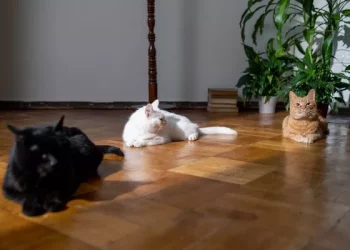The Chartreux cat, with its striking blue-gray coat and charming personality, has captivated the hearts of cat lovers worldwide. Known for its robust build and playful nature, this breed is also renowned for its relatively low shedding tendencies. In this article, we will delve into the shedding habits of the Chartreux cat, exploring the factors that influence shedding, grooming practices, and tips for maintaining a clean home.
Understanding the Chartreux Breed
Before we address the shedding specifics, let’s take a closer look at the Chartreux breed itself. This ancient breed hails from France and is characterized by its unique physical and personality traits.
Physical Characteristics
The Chartreux cat is a medium to large-sized breed with a muscular body, rounded head, and prominent cheekbones. Its coat is dense and woolly, providing a soft texture that many find appealing. The eye color ranges from copper to gold, creating a striking contrast against its blue-gray fur.
Personality Traits
Chartreux cats are known for their gentle and affectionate nature. They are typically friendly, intelligent, and easygoing, making them great companions for families and individuals alike. They tend to bond closely with their human counterparts and can often be seen following their owners around the house.
Shedding in Cats
Shedding is a natural process for all cats, including the Chartreux. Understanding why cats shed and the factors that contribute to it can help pet owners manage their cats’ grooming needs effectively.
Why Do Cats Shed?
Cats shed their fur to remove old or damaged hair and to adapt to changing environmental conditions. Shedding helps regulate body temperature and is influenced by factors such as season, health, and diet.
Seasonal Shedding
Most cats, including the Chartreux, experience increased shedding during certain times of the year. In spring, as the weather warms up, cats shed their winter coats to prepare for summer. Similarly, in fall, they may shed some of their summer coat to make way for a thicker winter coat.
Factors Influencing Shedding
Several factors can affect how much a cat sheds, including:
Genetics: Some breeds are known to shed more than others. The Chartreux is considered a low-shedding breed.
Health: Cats with underlying health issues, such as allergies or skin conditions, may shed more.
Diet: A well-balanced diet contributes to a healthy coat. Poor nutrition can lead to excessive shedding.
Stress: Changes in the environment, such as moving homes or introducing new pets, can cause stress, leading to increased shedding.
Shedding in the Chartreux
The Chartreux is generally considered to be a low-shedding breed. Their unique coat texture helps reduce the amount of fur that ends up around the house. However, some shedding is inevitable, and understanding how to manage it is key.
Average Shedding Levels
While individual cats may vary, the Chartreux typically sheds less than many other breeds. Their dense, double-layered coat tends to hold onto loose hair rather than releasing it into the environment. This trait is particularly beneficial for allergy sufferers or those who prefer a cleaner home.
Comparison with Other Breeds
To put the Chartreux’s shedding into perspective, let’s compare it with a few other popular breeds:
Siamese: Known for their short, fine hair, Siamese cats can shed moderately, especially during seasonal changes.
Persian: With their long, luxurious coats, Persians are heavy shedders and require regular grooming to manage their fur.
Maine Coon: This large breed has a thick, water-resistant coat and sheds significantly, particularly during the shedding season.
In comparison, the Chartreux is on the lower end of the shedding spectrum, making it an appealing option for those concerned about fur around the house.
Grooming Your Chartreux Cat
Regular grooming is essential for maintaining the health of your Chartreux cat’s coat and minimizing shedding. Here are some tips for effective grooming:
Brushing Techniques
Frequency: Aim to brush your Chartreux at least once a week. During seasonal shedding periods, increase this to two or three times a week.
Tools: Use a slicker brush or a rubber grooming glove to effectively remove loose hair and prevent matting.
Technique: Start from the head and work your way down to the tail. Brush in the direction of hair growth to avoid discomfort.
Bathing
Although cats are generally good at self-grooming, occasional baths can help reduce shedding and keep the coat clean. Use a cat-specific shampoo and ensure you rinse thoroughly to avoid skin irritation. Bathing should be done only as needed, generally no more than a few times a year.
Nail Care
Regular nail trimming is also important for your cat’s health. Use a pair of cat nail clippers and trim the tips of the nails every few weeks. This helps prevent overgrowth and keeps your cat comfortable.
Dental Care
Dental health is crucial for your cat’s overall well-being. Brush your cat’s teeth regularly with cat-safe toothpaste to prevent dental disease, which can indirectly impact shedding by affecting their overall health.
Diet and Shedding
A nutritious diet plays a vital role in your Chartreux cat’s coat health. High-quality cat food that is rich in omega-3 and omega-6 fatty acids can contribute to a healthy, shiny coat and reduce excessive shedding.
Choosing the Right Food
When selecting cat food, look for products that contain:
High-quality proteins: Essential for muscle and coat health.
Omega fatty acids: Help maintain skin and coat health.
Vitamins and minerals: Ensure overall health and support the immune system.
Consult with your veterinarian to determine the best dietary options for your Chartreux, especially if you notice changes in shedding or coat condition.
Managing Shedding in the Home
Even though Chartreux cats shed less, it’s still important to manage the fur in your home. Here are some tips for keeping your living space clean:
Regular Cleaning
Vacuuming: Use a vacuum cleaner with a pet hair attachment to remove fur from carpets, furniture, and curtains.
Lint Rollers: Keep lint rollers handy for quick clean-ups on clothing and upholstery.
Washable Covers: Use washable slipcovers on furniture to protect them from fur, and wash them regularly.
Air Filtration
Using air purifiers can help reduce airborne pet dander and hair. Look for HEPA filters that capture small particles and allergens.
Designated Pet Areas
Create specific areas in your home where your Chartreux can spend time. This can help contain fur to certain areas, making it easier to manage.
Health Issues Related to Shedding
While the Chartreux is generally a healthy breed, excessive shedding can sometimes indicate underlying health problems. If you notice a significant increase in shedding or changes in your cat’s coat condition, consult your veterinarian. Some common issues to consider include:
Allergies: Food allergies or environmental allergens can lead to excessive shedding and skin irritation.
Parasites: Fleas, ticks, or mites can cause itching and lead to more shedding.
Skin Conditions: Fungal infections, dermatitis, or other skin issues can contribute to hair loss and increased shedding.
Stress: Changes in the home environment or routine can affect your cat’s well-being, leading to increased shedding.
Conclusion
In summary, the Chartreux cat is a wonderful breed known for its affectionate nature and striking appearance. While they do shed, they are generally low shedders compared to many other breeds. By understanding their grooming needs, maintaining a healthy diet, and managing your home environment, you can minimize shedding and enjoy a clean, fur-free space.
With the right care, your Chartreux can thrive and continue to be a beloved companion for many years to come. Whether you’re a seasoned cat owner or considering adding a Chartreux to your family, understanding their shedding habits and grooming requirements is key to a happy, healthy relationship with your feline friend.
Related Topics:

























